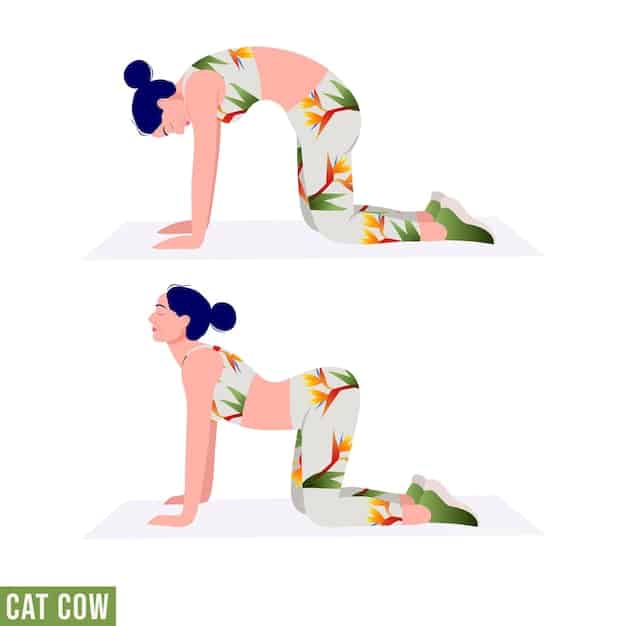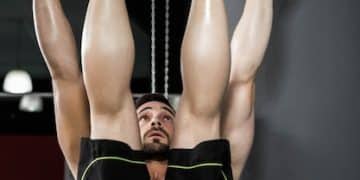3 Simple Exercises for Better Posture & Less Back Pain

Achieving optimal posture and alleviating persistent back pain can be significantly improved through a consistent routine of simple, targeted exercises that strengthen core muscles and align the spine, enhancing overall physical well-being and reducing discomfort.
In a world increasingly dominated by screens and sedentary lifestyles, maintaining good posture has become more challenging than ever. Yet, the benefits of proper alignment extend far beyond aesthetics, profoundly impacting overall health and well-being. This article delves into how just 3 simple exercises to improve your posture and reduce back pain can revolutionize your daily comfort and long-term spinal health.
Understanding the Posture-Pain Connection
Poor posture is often an overlooked culprit behind chronic back pain. When your body is misaligned, certain muscles become overstressed while others weaken, creating an imbalance that directly impacts the spine. This constant strain can lead to discomfort, stiffness, and even structural changes over time.
Recognizing the intimate link between how we hold our bodies and the pain signals we experience is the first step toward effective relief. It’s not just about sitting up straight; it’s about re-educating your body to adopt natural, efficient movement patterns that distribute weight evenly and minimize stress on the joints and ligaments.
The Anatomy of Bad Posture
Understanding which parts of your body are most affected by poor posture can provide clarity on why pain occurs. Often, it involves the entire kinetic chain, from your feet to your head.
- Jaw, neck, and shoulder tension, leading to headaches and restricted movement.
- Rounded shoulders and forward head posture, common with desk work.
- Pelvic tilt, affecting the lower back and contributing to sciatica.
- Weak core muscles, unable to support the spine effectively.
These issues, while seemingly minor individually, compound over time to create a cycle of pain and dysfunction. Breaking this cycle requires a targeted approach, focusing on strengthening weakened areas and stretching tight muscles to restore balance.
Addressing these foundational issues through consistent exercise can yield significant improvements. The goal is to create a more resilient and balanced musculature that naturally supports a healthier posture. This proactive approach not only alleviates existing pain but also helps prevent future issues from developing, ensuring long-term spinal health and comfort.
The Power of Targeted Exercises
While various complex regimens exist, the beauty of tackling posture and back pain lies in the simplicity of targeted exercises. Focusing on a few key movements that address core stability, shoulder retraction, and spinal mobility can deliver profound results without requiring hours in a gym or specialized equipment. These exercises are designed to counteract the effects of modern lifestyles, strengthening the muscles essential for maintaining an upright, pain-free posture.
The key to success with these exercises lies in consistency and proper form. Even just a few minutes each day, performed correctly, can make a significant difference. It’s about building foundational strength and awareness, enabling your body to naturally revert to better alignment throughout your daily activities. This targeted approach is more effective than generalized stretching or strengthening, as it directly addresses the muscular imbalances contributing to poor posture and back pain.
Why Simple is Effective
Complex routines can be intimidating and hard to maintain. Simple exercises, however, are easily integrated into daily life, making adherence more likely. They allow for a deeper focus on form, which is crucial for preventing injuries and maximizing benefits.
Moreover, simple movements often target multiple muscle groups simultaneously, providing a holistic strengthening effect. This efficiency means you can achieve significant improvements with minimal time commitment, making it feasible for even the busiest individuals to prioritize their spinal health.
By demystifying the process and providing accessible options, more people are empowered to take control of their posture and alleviate their back pain. The effectiveness isn’t in the number of exercises, but in the quality and consistency of those chosen. Small, consistent efforts in the right direction can lead to substantial, lasting improvements in both comfort and alignment.
Exercise 1: The Cat-Cow Stretch
The Cat-Cow stretch, often lauded in yoga practices, is an excellent exercise for improving spinal mobility and relieving tension in the back and neck. This gentle, flowing movement helps to warm up the spine, making it more flexible and responsive. It encourages coordination between breath and movement, enhancing body awareness critical for posture correction.
By engaging both flexion and extension of the spine, the Cat-Cow stretch promotes healthy disc lubrication and strengthens the muscles supporting the vertebrae. It’s particularly effective for those who spend long hours sitting, as it counteracts the stiffness and compression that often accumulate in the lower back.
Incorporating this exercise daily can significantly reduce morning stiffness and improve overall spinal health. Its simplicity makes it accessible to almost anyone, regardless of fitness level, providing a solid foundation for better posture and pain relief.
How to Perform the Cat-Cow Stretch
Begin on all fours, with your wrists directly under your shoulders and knees under your hips. Your spine should be in a neutral position.
- For Cat Pose: As you exhale, round your spine towards the ceiling, tucking your chin to your chest. Feel the stretch throughout your back.
- For Cow Pose: As you inhale, drop your belly towards the floor, arching your back and lifting your head and tailbone towards the ceiling.
- Flow between these two poses smoothly, coordinating each movement with your breath. Repeat 10-15 cycles.
Focus on maintaining a gentle, fluid motion, avoiding any jerky movements. The stretch should feel comfortable and elongating, not painful. Over time, you will notice increased flexibility and ease in your spine, contributing directly to better posture and reduced back discomfort. This exercise is foundational for anyone looking to improve spinal health and mobility.

Exercise 2: The Superman
The Superman exercise is a powerful yet simple movement that targets the often-neglected muscles of the posterior chain, including the lower back, glutes, and hamstrings. Strengthening these muscles is crucial for countering the forward-slumped posture common in modern life. By building resilience in these areas, the Superman helps to stabilize the spine and pull the shoulders back, promoting an upright posture and reducing strain on the lower back.
This exercise is particularly beneficial for those with weak back extensors or rounded shoulders. It helps to create a stronger foundation for the spine, allowing it to maintain its natural curve with less effort. Consistent practice of the Superman can significantly improve spinal alignment and alleviate chronic low back pain, making everyday movements feel lighter and more comfortable.
Executing the Superman Correctly
Lie face down on the floor with your arms extended forward and legs straight behind you.
- As you exhale, simultaneously lift your arms, chest, and legs a few inches off the floor. Keep your neck neutral, looking down at the floor.
- Hold this position for 2-3 seconds, engaging your back muscles and glutes.
- Gently lower back to the starting position. Repeat for 10-15 repetitions, focusing on controlled movement rather than height.
Avoid arching your neck too much or using momentum to lift. The power should come from your back and gluteal muscles. This controlled movement ensures that the correct muscles are engaged, maximizing the benefits for posture and pain relief. Consistent performance will lead to noticeable improvements in core strength and spinal support.
Exercise 3: Wall Angels
Wall Angels are an excellent exercise for improving upper back posture, shoulder mobility, and strengthening the muscles that retract the shoulder blades. This movement directly addresses rounded shoulders and forward head posture, which are common contributors to neck and upper back pain. By pressing your entire back against a wall, you engage muscles that help to align your spine naturally.
This exercise also enhances proprioception, your body’s awareness of its position in space, which is vital for maintaining good posture throughout the day. Wall Angels help to open up the chest and improve thoracic spine mobility, making it easier to breathe deeply and stand taller. Its simplicity allows for daily practice, providing continuous benefits for overall spinal health and comfort.
Steps for Perfect Wall Angels
Stand with your back against a wall, heels about 6 inches away. Ensure your head, upper back, and sacrum are touching the wall. Bend your elbows to 90 degrees, bringing your arms up so your upper arms are parallel with your shoulders, and your forearms are perpendicular, trying to keep your wrists and elbows touching the wall.
- Slowly slide your arms up the wall, keeping your wrists, elbows, and back of your head in contact with the wall as much as possible.
- Extend your arms fully above your head, then slowly lower them back to the starting position.
- Perform 10-15 repetitions, focusing on maintaining full contact with the wall throughout the movement.
It’s common for some parts of your arms or head to lift off the wall, especially if you have significant stiffness or rounded shoulders. Focus on a comfortable range of motion, and over time, your flexibility will improve. This exercise effectively addresses postural imbalances, leading to a more erect and less painful posture.

Integrating Exercises into Your Daily Routine
Consistency is paramount when it comes to improving posture and reducing back pain. Incorporating these simple exercises into your daily routine doesn’t require a significant time commitment, but rather a conscious effort to prioritize your well-being. Think of them as non-negotiable mini-breaks throughout your day, providing vital support for your spine and muscles. Even 5-10 minutes spread across the day can make a remarkable difference, turning sporadic efforts into sustainable habits.
Instead of viewing exercise as a burdensome task, frame it as an opportunity for self-care and pain prevention. Simple cues, such as a timer on your phone or a specific time of day (like after waking up or before bed), can help solidify these routines. Remember, the cumulative effect of small, consistent actions far outweighs occasional intensive workouts. By seamlessly integrating these movements, you empower your body to maintain better alignment naturally, reducing the likelihood of pain flare-ups and fostering long-term spinal health.
Building Sustainable Habits
Start small and gradually increase repetitions or duration. The goal is to make these exercises feel like a natural part of your day, not a chore.
- Link exercises to existing habits, such as doing them after brushing your teeth or during a coffee break.
- Set realistic goals and celebrate small victories to stay motivated.
- Listen to your body; some days you may feel more flexible than others. Consistency trumps intensity.
Remember that improvement is a journey, not a destination. There will be days when it’s harder to stick to your routine, but the important thing is to resume as soon as possible. Over time, these simple additions will become ingrained, leading to significant and lasting improvements in your posture and overall comfort.
Beyond Exercises: Holistic Approaches to Posture
While targeted exercises are incredibly effective, a holistic approach amplifies improvements in posture and reduces back pain. This involves a combination of mindful habits, ergonomic adjustments, and lifestyle choices that collectively support spinal health. Recognizing that posture is influenced by every aspect of your daily life allows for a multidimensional strategy to achieve lasting comfort and alignment.
True postural correction extends beyond isolated movements; it’s about cultivating a greater awareness of your body in space and making conscious choices that support its natural alignment. By integrating these broader strategies, you create an environment that encourages optimal posture, making the benefits of exercise even more profound and sustainable. It’s about building a lifestyle that inherently supports a strong, pain-free back.
Lifestyle Adjustments for Better Posture
Consider how your daily environment might be contributing to poor posture. Small changes can make a big difference.
- Ergonomics: Adjust your workstation to support neutral posture. Ensure your screen is at eye level, your feet are flat on the floor, and your chair provides lumbar support.
- Movement Breaks: Stand up and move around every 30-60 minutes, even if it’s just for a minute. This breaks up sedentary periods and re-sets your posture.
- Mindful Awareness: Regularly scan your body throughout the day, checking in on your posture. Are your shoulders rounded? Is your head leaning forward? Gently realign.
Implementing these habits alongside your exercises creates a powerful synergy. They reinforce the muscular improvements gained from exercise and help you maintain good posture even when you’re not actively working on it. This integrated approach ensures comprehensive support for your spine and reduces the likelihood of chronic pain, fostering a healthier, more comfortable daily existence.
By blending regular exercise with mindful daily habits and ergonomic adjustments, you create a comprehensive strategy for superior posture and reduced back pain. This multi-faceted approach doesn’t just treat symptoms; it addresses the root causes of misalignment, paving the way for lasting relief and enhanced well-being. It’s a commitment to a healthier self, one conscious choice at a time, transforming how you live and move.
| Key Posture Point | Brief Description |
|---|---|
| 🧘🏽♀️ Cat-Cow Stretch | Improves spinal mobility, reducing stiffness and promoting flexibility. |
| 🦸♂️ The Superman | Strengthens lower back, glutes, and hamstrings for spinal stability. |
| wall Angels | Corrects rounded shoulders and improves upper back mobility. |
| 🎯 Consistency | Regular practice is key to long-term posture improvement and back pain relief. |
Frequently Asked Questions About Posture and Back Pain
Significant posture improvements can often be seen within a few weeks to a few months of consistent exercise and mindful daily habits. Minor changes might be noticeable even sooner, but long-term gains require dedication. Factors like the severity of issues and consistency of practice influence individual progress.
While these exercises can significantly alleviate and manage chronic back pain by strengthening supporting muscles and improving alignment, they may not “cure” underlying conditions. They are powerful tools for pain reduction and prevention. Consulting a healthcare professional for persistent or severe pain is always recommended.
These exercises are generally safe for most individuals when performed correctly. However, if you have pre-existing injuries, severe pain, or certain medical conditions, consult a doctor or physical therapist before starting. Listen to your body and stop if you experience sharp pain, rather than pushing through discomfort.
For optimal results, aim to perform these exercises daily or at least 3-5 times a week. Consistency is more important than intensity. Even short sessions (5-10 minutes) done regularly will yield better results than sporadic, longer workouts. Integrate them into your routine for sustained benefits.
No special equipment is required for the Cat-Cow Stretch, Superman, or Wall Angels. You just need a comfortable floor space or a sturdy wall. This makes these exercises highly accessible and easy to incorporate into your home routine, eliminating the need for gym memberships or additional purchases.
Conclusion
Improving posture and reducing back pain is an attainable goal that starts with understanding the profound connection between how we hold our bodies and the discomfort we experience. The three simple exercises – the Cat-Cow stretch, the Superman, and Wall Angels – offer a foundational yet effective routine for strengthening vital support muscles and promoting spinal alignment. By consistently integrating these movements into your daily life, coupled with mindful ergonomic adjustments and a holistic approach to well-being, you can significantly enhance your physical comfort and confidence. Remember, the journey to better posture is a continuous one, empowering you to live with greater ease and less pain.





